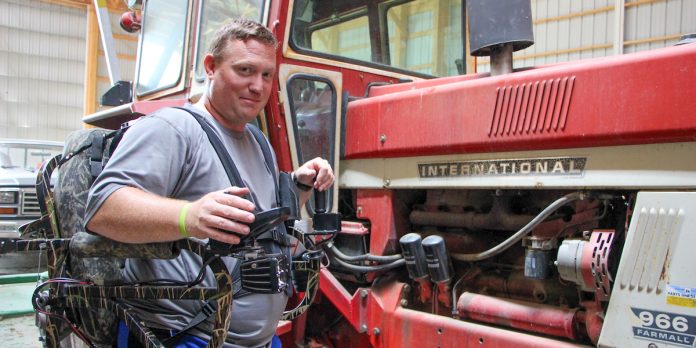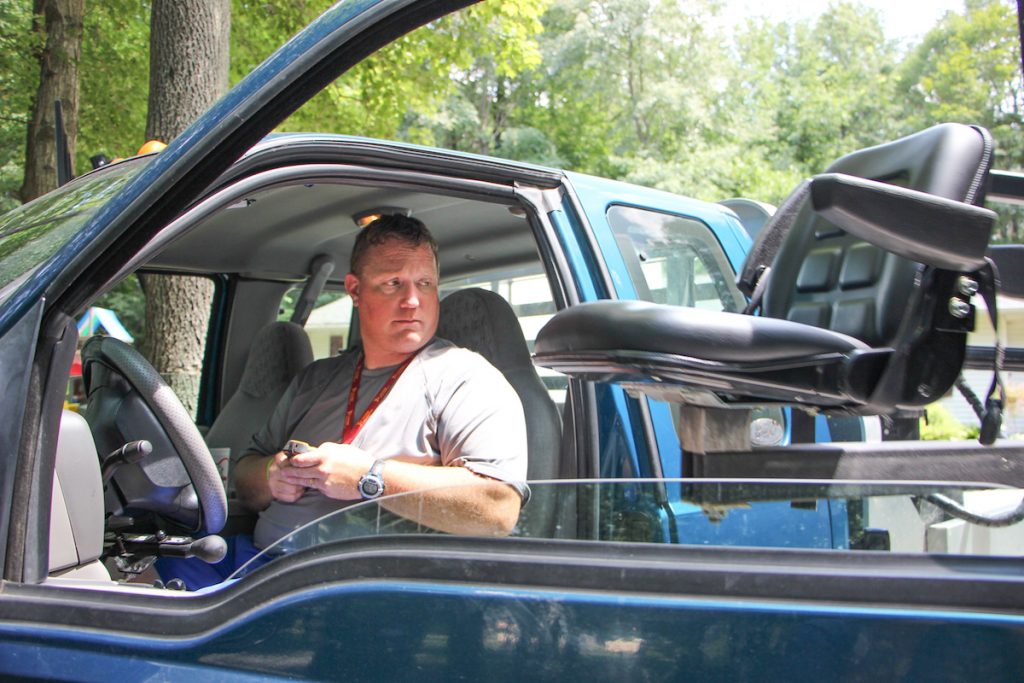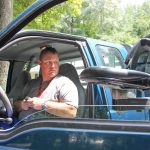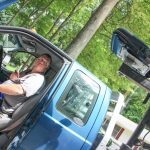
HARROD, Ohio — Jeff Austin was lying in a hospital bed at The James Cancer Center in Columbus, paralyzed from the waist down.
Ever since he could remember, he had helped his dad on the family grain farm in Allen County, Ohio.
As a young child, he recalls sleeping on the floor of the tractor while his dad worked the ground.
Yet here he was, at 39 years old, about to start an intense round of chemotherapy for stage 4 cancer.
He looked at his wife and said, “I’ll never get to drive that combine again.”
Collapsed
Jeff and Kristi Austin, and their four children, live in Harrod, Ohio, where Jeff worked full time for the Lima Refinery and farmed 450 acres of corn and soybeans with his dad.
In June 2013, Jeff started experiencing back pain and headaches, so he went to his family doctor, who recommended having his wisdom teeth removed. The headaches went away, but the back pain was still there.
“Both my boys are big boys. We always wrestle, and working at the refinery can be a physically demanding job; same with farming.” Jeff assumed he had simply “tweaked” his back.
“It all went to crap July 25, 2013,” he said.
“I was supposed to go to work that morning. I got up, used the restroom, turned on the water to wash my hands and I had a sharp, shooting pain down my right leg.”
As Jeff turned to walk out of the door, another sharp, shooting pain went down his left leg. He collapsed in the hallway.
• • •

“We had been to the doctor numerous times and they wouldn’t do an MRI for back pain,”
said Kristi, who said they spent six weeks visiting doctors and trying to figure out why Jeff was in so much pain.
“The back pain was so severe. The doctor pretty much accused me of being addicted to painkillers,” said Jeff.
“We had just got our orders for an MRI the night before, because he was in such terrible pain,” said Kristi. They didn’t have a chance to get it taken before he collapsed.
• • •
Jeff army crawled down the hallway and out to living room where his wife and son, Caleb, lifted him onto the couch.
“I had no strength, none at all, and the pain wasn’t subsiding any.”
“We tried to load (Jeff) in the car and we couldn’t — so we called the squad,” said Kristi.
It’s cancer
Over the next several hours, Jeff went through a series of tests at St. Rita’s Medical Center in Lima. And he started to lose feeling in his legs.
After the MRI, the doctors looked at the Austins, and Kristi recalls their words to this day: “‘It’s cancer, it’s bad, we can’t touch it here, he’s getting life-flighted to the James, we got to go’ — it was just like that,” she said.
The helicopter arrived at the hospital in 20 minutes.
• • •
A family member drove Kristi to the hospital. She tried to remain calm, knowing she would not be by Jeff’s side when the helicopter landed. She remembered Jeff had a friend from work who was paralyzed after falling from a ladder, and that he went to daily therapy in Columbus.
After a quick phone call, Kristi was able to arrange for Jeff’s friend, Mike, to be waiting for Jeff when he got off the helicopter.
Then she hit rush hour traffic heading into Columbus.
“I remember traffic was stopped and I was telling myself over and over, ‘stay in the car, stay in the car, stay in the car,’ because it just seemed like since we weren’t moving that I should just get out and go,” she said.
When they reached the hospital, Mike’s wife ran to meet them. “And she just grabbed me and rushed me back there so I could see him before he went into surgery,” said Kristi.
What’s next?
AgrAbility is a resource for technical support and education for people with disabilities involved in agriculture. It is funded through USDA as a four-year grant through the farm bill.
Twenty-one states have a funded program through a land-grant university partnered with a nonprofit disability organization.
Ohio State University partners with Easterseals and Penn State University partners with United Cerebral Palsy of Central Pennsylvania.
AgrAbility does not have the funds to provide equipment, but works with partners to find grants such as Opportunities for Ohioans with Disabilities or the PA Office of Vocational Rehabilitation.
AgrAbility offers on-site assessments to help individuals find the right equipment to continue to farm with a disability.
For more information about the Ohio AgrAbility program click here.
For more information about the Pennsylvania AgrAbility program click here.
For more information on the USDA AgrAbility program click here.
Visit Ohio AgrAbility at the Farm Science Review, Sept. 19-21, on Land Avenue between Market and Kottman Streets.
They performed an emergency surgery in the middle of the night to relieve some of the pressure, and Jeff spent the next few days in the Surgical Intensive Care Unit (SICU) while the doctors determined their next move.
Plans were made to start therapy at the Dodd Rehabilitation Hospital (across the parking lot from The James) to deal with the paralysis, but then the report came back: Jeff was diagnosed with stage 4 Diffuse large B-cell lymphoma, a form of non-Hodgkin cancer, and it had spread throughout his body.
A tumor was found in his nasal cavity — causing one eye to go in a different direction — on various organs and compressing his spinal cord, causing the paralysis. Jeff was started right away on some intense rounds of chemotherapy.
“When he was in his first round of chemo, I remember (Jeff) looking at me and saying, ‘I’ll never get to drive that combine again’,” said Kristi. The family had just purchased a combine in April and it was delivered in June.
“I drove it once,” said Jeff.
“Jeff had driven it over and parked it in a friends machine shed and that’s the only time he had ever driven it, and he was sure he would never get to drive it again,” said Kristi.
Jeff spent the next several months in and out of the hospital and rehabilitation center. “He went to Columbus on July 25 and he left Columbus on Oct. 17,” said Kristi.
After Jeff was released from the hospital in October, he was home for a week and then back in the hospital for a week, and then home and back again throughout November and December. A stem cell transplant put him in the hospital for the entire month of January 2014.
Community comes together
Three weeks after the diagnosis, it was clear Jeff and Kristi would miss their children’s participation in the Allen County Fair, and “we never miss a day of the fair,” Kristi said.
Their son Caleb called them in the hospital as he was getting ready to sell at the livestock auction and stuck his phone in his pocket, so his parents could hear the sale. At the same time, Kristi’s grandpa called her, saying they needed to hear what was going on “…and the bidding just went on and on and on.”
Jeff and Kristi were in tears when a nurse walked in, panicked that something was wrong.
Both Jeff and Kristi couldn’t get over the outpouring from the community. Kristi, a teacher at Allen East Elementary, missed a whole year of school, but her fellow teachers donated their sick days so she would still get a paycheck, and Jeff’s refinery co-workers made “Team Austin” T-shirts and sold them to raise money for the family.
“The school was awesome, the community was awesome,” said Jeff.
People brought meals to the family, took the children back-to-school shopping and even made sure they had rides to their school events.
“There was one mom on Cole’s football team that was in charge of taking Cole to every football practice, every game,” said Jeff. “There was someone in charge of taking Caleb to all his practices, and a cheerleading coach that picked Mallory up for all the cheerleading things.”
People even took their youngest daughter to spend the night. “Marah was three when her daddy got sick,” said Kristi.
“She was a Godsend,” said Jeff. “She spent a lot of time with us (at the hospital).”
Marah would jump up on the bed with her dad, giving Jeff hugs and making him smile. “I’d forget about the bad things,” he said.
AgrAbility
When Jeff was still in and out of treatment, a friend of the family, who worked for Ohio State University Extension, brought Jeff information about Ohio State’s AgrAbility Program and said, “I don’t know when you will be ready for this, but here it is when you are ready.”
Jeff and Kristi had started researching different mobility places to get a lift installed on their family’s Ford Expedition. They were told they would have to get a minivan, or try a two-door car.
Going back through the AgrAbility packets, Jeff found a running board lift through Life Essentials and had it installed in July of 2014.
“The problem with that lift is, it’s portable, but it didn’t have the reach to get me into the combine without doing a lot of things,” said Jeff. There was also no way to get Jeff into his truck.
So Jeff and Kristi started working with AgrAbility and were able to trade in the small lift for a lift system that he could put on his truck. The truck lift was installed in August of 2015 and a set of portable hand controls allowed him to drive his own truck again.
Jeff was slowly starting to regain his independence.
Regaining independence
In the fall of 2015, Jeff Austin was able to use this truck lift, installed on the back of his Ford F-350, to get into his combine for the first time in two years. (Catie Noyes)
 View
View
Regaining independence
In the fall of 2015, Jeff Austin was able to use this truck lift, installed on the back of his Ford F-350, to get into his combine for the first time in two years. (Catie Noyes) View
View
Up in the air
Not only can Jeff Austin use his truck lift to get into his truck and combine, but he has used it to trim trees. The truck lift can reach up to 12 feet high. (Catie Noyes photo) View
View
Full Extension
When fully extended, the lift can reach up to 14 feet from Jeff Austin's F350. (Catie Noyes photo) View
View
Truck lift
After pulling himself into his truck, Jeff Austin can easily move his chair lift back in position on the back of his truck. (Catie Noyes photo) View
View
Buckle up
Jeff Austin can easily lower his chair lift beside his action track chair so he can get onto the seat. (Catie Noyes photo)“Sometimes he needed a nudge, and sometimes he needed a push, and then I would be praying, ‘please let things go well, because if things go bad, he’s not going to want to try it again,’” said Kristi.
But now Jeff could drive his children to and from school and take himself to therapy.
Most importantly, in the fall of 2015 — two years after his diagnosis — he could get into the combine, which he said was an incredible feeling.
• • •
That first harvest after Jeff was diagnosed with cancer, his family sent him pictures of the new combine out in the field. “That was cool,” said Jeff, who admitted it was also a little hard knowing he couldn’t be a part of it.
When he was first released from the hospital, Jeff knew he wanted to do something to help out with harvest, so he brought the crew lunch.
“They were shelling corn, and that was hard because it was fun to watch but I’m not a watcher — I’ve got to be part of it,” he said. “So at least I could do something.”
• • •
When his family brought out Jeff’s truck lift and he was able to get in the combine for the first time, he knew he wouldn’t be leaving that seat until harvest was over.
“It’s hard for Dad to get me out. If I’m in, I’m running it,” he said. “There’s very little of harvesting I don’t do.”
The spring of 2016 was the first spring Jeff was able to work ground and in the fall of 2016, Jeff was able to work on equipment with the help of an Action Track Chair.
Independent
The Action Track Chair has given Jeff a lot of independence.
They took the track chair to a spring track meet, and Kristi said, for the first time in three years, she didn’t have to be by his side.
“He’s like, ‘going to the concession stand, see ya later,’ and he just took off on his own,” she said. “You don’t know how amazing that is until you’ve had it the other way, where you’ve had to be right there every minute ready to help.”
For Jeff, the track meet brought another milestone.
“That first time I was able to stand for the national anthem at a track meet was just — it was just amazing,” he said.
“You guys stand all the time and you’re used to it,” he added. “To look people in the face to talk to them, there’s nothing like it.”

A new normal
Jeff is currently in remission, only seeing the doctor every six months and hasn’t had a positron emission tomography (PET) scan — an imaging test that allows a doctor to check for diseases in the body — in two years.
In some ways, the Austins see the incident as a blessing. Unable to return to his job at the refinery, he now volunteers at the school with his wife.
“He used to miss a lot of stuff the kids were in because of his work schedule and now he can be there. So, in a weird way, it can be a blessing,” said Kristi.
“We’ve met so many people on this journey; we wouldn’t change anything,” said Jeff.
“This hasn’t stopped me doing anything,” he said. “It slows us down, but we still do it all.”
Since he has been working with AgrAbility to get the equipment he needs, he has shared his story in the AgrAbility tent at the Farm Science Review, helping others find hope that they can return to a normal life.
“The equipment that is available from Life Essentials is amazing. It gets you back to a norm,” he said. “It’s a new normal, but it’s a norm.”









